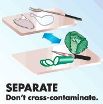
National Study Assessing Food Allergies' Prevalence in Canada
Canada's health minister, Tony Clement, yesterday announced the launch of a national study on the prevalence of food allergies among Canadians. Clement also announced new national labeling requirements for food allergens, gluten sources, and added sulfites that are in prepackaged foods.
"The government of Canada is taking action to protect the health and well-being of Canadians with food allergies and celiac disease," said Clement, who said the labeling rules "will provide Canadians with the information they need to manage their own allergies and give parents greater assurance about the food they give their children who may have allergies."
He called on manufacturers to take proactive steps to improve labeling of food allergens. "Ensuring safe foods for Canadians is a collaborative effort between government, industry, and consumers," Clement said. "Until the regulatory amendments proposed by my department are enacted, we are asking industry to be proactive in improving labeling of food allergens and gluten sources to protect the health of Canadians."
"Reading food labels is the first line of defense for food-allergic consumers," said Laurie Harada, executive director of Anaphylaxis Canada. "Making sure that Canadians can identify foods which could cause an allergic reaction is essential. The proposed regulatory amendments will be an important tool to protect and improve the quality of life for food-allergic consumers."
The food allergy prevalence study is being initiated by the Allergy, Genes and Environment Network and co-sponsored by Health Canada; it will examine which foods are the most common causes of allergic reactions. It will be the largest study thus far of food allergy prevalence in Canada; up to 6 percent of young children and 4 percent of adults in the country are believed to suffer from food allergies, according to Health Canada.